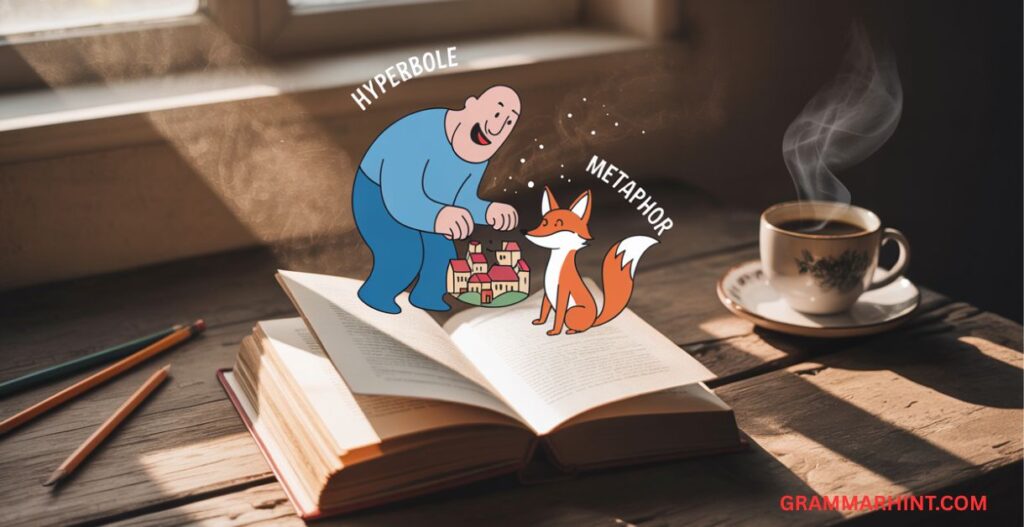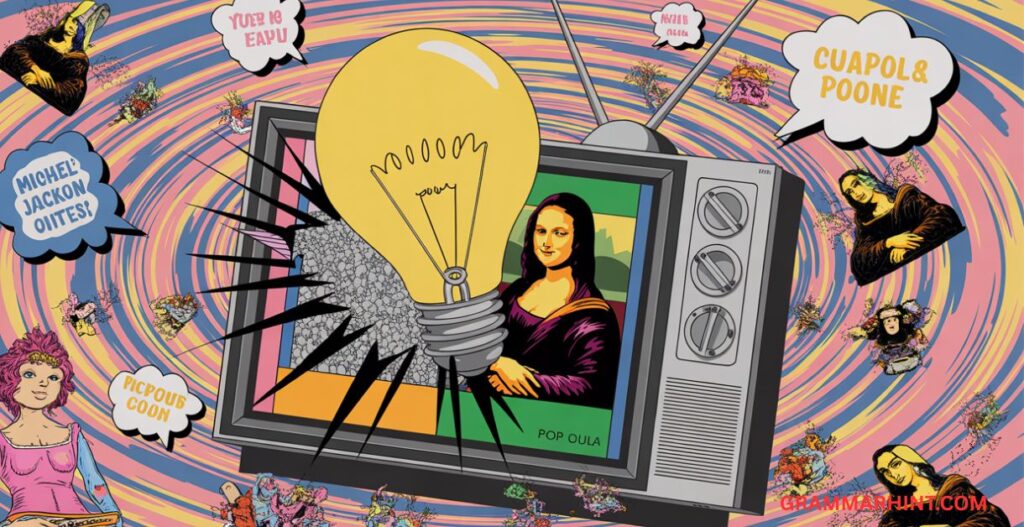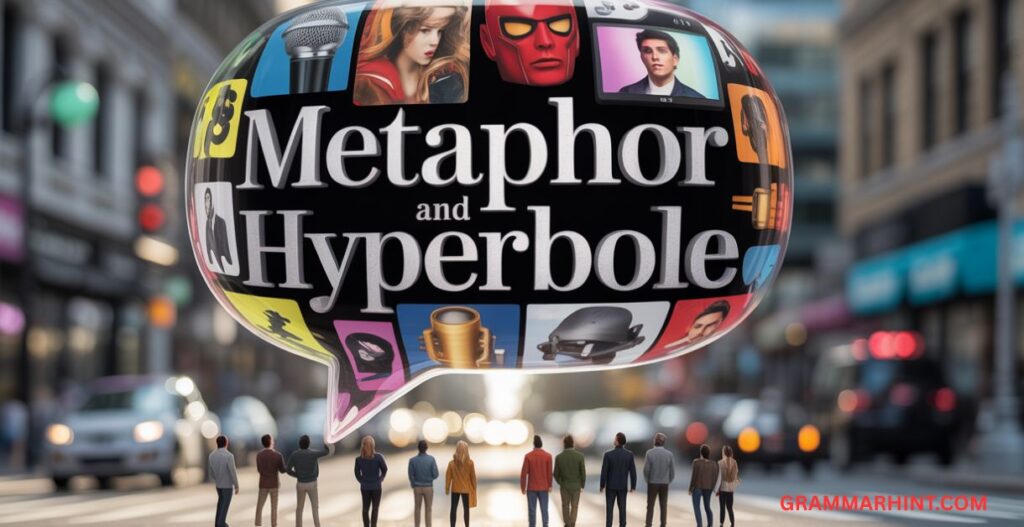Language is more than just a method of communication; it’s a canvas of creativity, a room where words act as brushes painting expressive ideas. Among the many language tools, metaphor and hyperbole stand tall as champions of vivid expression. These two figurative language powerhouses often leave learners and even native speakers wondering: what’s the real difference between metaphor and hyperbole? Let’s break it down, stage by stage.
What Is a Metaphor?
A metaphor is a figure of speech that makes an imaginative comparison between two unrelated things, stating that one is the other. It doesn’t use the words “like” or “as,” unlike a simile. Instead, it makes a symbolic leap, creating verbal illustration that adds depth to your writing or speech.
Example:
“Time is a thief.”
Here, time isn’t literally stealing anything. But just like a thief, it quietly takes moments from us without us noticing.
This kind of expression in writing helps you say more by showing emotions or concepts rather than stating them outright. It creates mental pictures that stick.
What Is Hyperbole?
Hyperbole is a rhetorical device that uses exaggeration to make a point or show strong emotion. It’s not meant to be taken literally; it’s a kind of word magic trick—a flourish that gives your words flair.
Example:
“I’ve told you a million times!”
Of course, no one literally repeats something a million times. But this overstatement is used to emphasize frustration or importance.
Hyperbole and metaphor both fall under the umbrella of figurative language, but their purposes and effects are distinct.
The Key Difference Between Metaphor and Hyperbole
The difference between metaphor and hyperbole lies in the technique and intent:
| Feature | Metaphor | Hyperbole |
|---|---|---|
| Core Function | Compare one thing to another | Exaggerate for emphasis |
| Literal Meaning | Not literal | Not literal |
| Emotional Tone | Subtle, poetic | Dramatic, intense |
| Use in Writing | Creative writing techniques, poetry, narrative | Dialogues, humorous writing |
| Effect on Reader | Encourages reflection | Evokes amusement or shock |
So, while both use imagination and play with language, they work differently.
Why the Confusion?

In many cases, hyperbole vs metaphor gets confused because they often appear together in expressive language.
Consider this:
“Her suitcase weighed a ton.”
This is hyperbole, because it’s clearly an exaggeration. But what if someone said:
“Her words were a suitcase full of guilt.”
This is a metaphor. Guilt isn’t literally packed in a suitcase, but it paints an image of emotional baggage.
Metaphor in Action – Scenario Example
Email Scenario – Creative Writing Class
Subject: Feedback on Your Narrative Essay – “The Broken Clock”
Hi Emily,
I just finished reading your piece and I must say—your metaphor of the clock being a “silent judge” was brilliant. It added depth to your theme of waiting and wasted time. That kind of figurative language elevates your story.
Let’s continue to use more of these speech and writing tools to enhance your writing.
Warm regards,
Ms. Turner
Creative Writing Instructor
Hyperbole in Action – Scenario Example
Email Scenario – Marketing Campaign Draft
Subject: Revised Tagline Suggestions
Hi Jacob,
I took a look at the product pitch, and here are some hyperbole-driven lines that might engage the audience:
- “So good, it’ll blow your taste buds to another dimension!”
- “The only energy drink that makes gravity jealous.”
Let’s review which ones feel on-brand but still playful.
Best,
Lara Chen
Brand Strategist
Simile vs Metaphor
People also confuse simile vs metaphor. Here’s a quick breakdown:
- Simile: “He’s as brave as a lion.”
- Metaphor: “He is a lion in battle.”
Similes compare using “like” or “as”. Metaphors make the leap, stating the comparison outright.
When to Use Each – Practical Tips

Knowing whether to use a metaphor or hyperbole depends on your narrative techniques and goals.
Use Metaphors When You Want To:
- Evoke imagery and symbolism
- Convey deep or abstract emotions
- Add literary flair
Use Hyperbole When You Want To:
- Emphasize emotion or action
- Be humorous or dramatic
- Create memorable slogans or expressions
Common Mistakes to Avoid
- Mixing metaphors: Avoid combining unrelated descriptive phrases, e.g., “We’ll cross that bridge when it’s burning.”
- Overusing hyperbole: Too much exaggeration can make writing feel insincere.
- Confusing tone: A poetic metaphor in a legal email? Maybe not the best idea.
Metaphor and Hyperbole in Pop Culture

Movie Metaphor:
“Life is a journey, not a destination.” – Various sources
Song Hyperbole:
“I would walk 500 miles and I would walk 500 more…” – The Proclaimers
Both showcase engaging communication using figurative language.
H2: Metaphor and Hyperbole for English Language Learning
For learners, grasping the difference between hyperbole and metaphor enhances fluency, comprehension, and self-expression. They’re essential writing enhancement tools.
Study Tip:
- Make a two-column notebook: one for metaphors you encounter, one for hyperboles.
- Translate them literally—then interpret their meaning.
Final Thoughts – Your Word Magic Toolbox
In the vibrant world of creative writing techniques, hyperbole and metaphor are your best friends. They make your ideas more vivid, your emotions more real, and your expression in writing more captivating. Whether you’re crafting a poem, pitching a product, or simply trying to talk with flair, these speech and writing tools stretch the limits of ordinary communication.
So the next time you want to show instead of say, or exaggerate to entertain, reach into your language suitcase—there’s a metaphor or hyperbole waiting for you.
Quick Recap – Difference Between Metaphor and Hyperbole
- Metaphor = Comparison without like/as, symbolic and poetic.
- Hyperbole = Exaggeration for emphasis, dramatic or funny.
Master both, and you’ll never run out of tricks to turn your words into gold.
Useful Examples of Figurative Language
- Metaphor: “Her eyes were oceans of mystery.”
- Hyperbole: “I’m so hungry I could eat a horse.”
- Simile: “He’s like a volcano ready to erupt.”
These examples show the range of verbal illustrations you can use to make your writing come alive.
Final Note: Why It Matters
Understanding the difference between metaphor and hyperbole isn’t just academic—it’s essential for engaging communication, storytelling, and even marketing. They aren’t just writing enhancement tools; they’re tools of persuasion, creativity, and clarity.
So go ahead write like your pen is a paintbrush. Talk like every word is a performance. And remember, every phrase is a chance to turn your message into a masterpiece.
Now, grab your notebook or open that doc and use these insights to craft stories, emails, essays, or slogans that shine. Because once you understand how to compare, exaggerate, and express, you’ve unlocked the language that makes writing not just clear but unforgettable.









